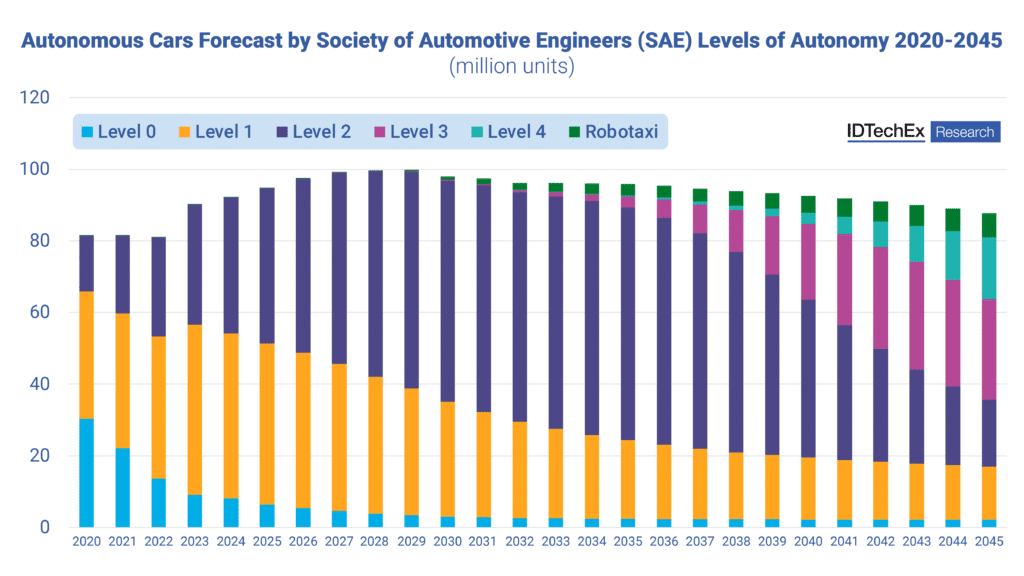When the Society of Automotive Engineers released their definitions of varying levels of automation from level 0 to level 5, it became easier to define and distinguish between the many capabilities and advancements of autonomous vehicles. Level 0 describes an older model of vehicle with no automated features, while level 5 describes a future ideal of a vehicle that is fully autonomous in all situations and requiring no human intervention. IDTechEx‘s report, “Autonomous Vehicles Market 2025-2045: Robotaxis, Autonomous Cars, Sensors“, explores players operating within the increasingly innovative field, and progressions predicted to be made within the market over the next two decades.
Stepping from Level 2+ to Level 3
Level 2+ can be described as a stepping stone between levels 2 and 3, where drivers can take their hands off the wheel in certain situations but are still expected to keep their eyes on the road and maintain normal focus. Level 3, however, allows drivers to take their hands and eyes off the road, shifting the liability for collisions into the hands of vehicle manufacturers. Automotive OEMs will therefore need to reach a point of confidence in their autonomy as to ensure their liability costs are not greater than the potential revenue from deploying Level 3 systems.
Supervision and functionality remain in the balance as values to prioritize for OEMs choosing to employ higher levels of automation. While Level 2+ vehicles can be driven hands-free at normal speeds on highways, they require constant supervision. Level 3, on the other hand, allows eyes-off driving but is more limited, currently only available at low speed on motorways, hamstringing its utility and value.
Global progressions for autonomy
Level 2 is now widely available globally with almost all manufacturers offering Level 2. However, there is now a real growing uptake of higher levels of vehicle automation. Level 2+ is currently allowed in US, with no barriers in place to stop commercialization, while according to IDTechEx’s research, the UK already has level 2+ deployment from Ford, with more vehicles expected to use the technology as of this year. Advancements into even higher levels of automation are also being seen in use. California, Nevada, and Germany are making use of Mercedes Level 3 flagship models, with the UK potentially seeing Level 3 vehicles on the roads by 2026. Robotaxi deployment also sees Level 4 up and running in multiple states in the US, including California, Texas, and Arizona, and Chinese cities such as Beijing and Shanghai.
Players and predictions for Level 2+ autonomy
IDTechEx’s report explores the main players within the vehicle automation industry using Level 2+ and above, including Honda, Mercedes, and BMW. Honda’s focus on safety sees their vehicles using automated safety features such as automotive emergency braking, cruise control, and lane keep assist. Level 2+ is likely to be implemented by multiple other OEMs as a means to enhance safety, as the technology could help reduce the number of collisions caused by human error.
Level 3 can currently be seen in use by Mercedes S-Class, which operates their ‘Drive Pilot’ technology in a number of regions within Germany, California and Nevada. While level 3 systems have been limited to 60kph since 2022, Mercedes announced in September 2024 that they would be increasing this limit to 95kph, with a vehicle update planned this year. The BMW 7 Series is also described as a main competitor for the Mercedes S-Class by IDTechEx, as it received level 3 approval in 2023, with the technology being made available in Germany in 2024.
IDTechEx predicts that the combination of reduced legislative barriers and liability from OEMs will make Level 2+ the most feasible option for vehicles looking to automate going forward, with Level 3 still needing to prove itself to manufacturers as worth taking the extra step towards increased liability.
For more information, including downloadable sample pages, please see www.IDTechEx.com/AutoVehicles.
For the full portfolio of autonomy market research available from IDTechEx, please see www.IDTechEx.com/Research/Autonomy.
About IDTechEx
IDTechEx provides trusted independent research on emerging technologies and their markets. Since 1999, we have been helping our clients to understand new technologies, their supply chains, market requirements, opportunities and forecasts. For more information, contact [email protected] or visit www.IDTechEx.com.


